
What to look out for in a good Knife
Good quality modern knives are made from high carbon stainless steel. This combines the softness of carbon steel for ease of sharpening with the strength of stainless steel.
Old fashioned high-carbon steel blades tarnish easily but they sharpen to a better edgea nd the blade is also more flexible. Careful maintenance is required the blade must be wiped dry after use and needs to be washed after cutting acidic produce such as onions.
Look for sturdy construction with the tang (handle end of the blade) running inside the handle and attached solidly with rivets.
The heel at the wide end of the blade reinforces the blade and protects the fingers.

Choose the right knife for the job. Flexible or rigid, long or short bladed.
Handle How is the handle made? Is it plain hardwood or an elegant rosewood? Is it a synthetic handle, with easier care and more grip and won't crack. Take the size of your hand into account: is it too large or small for the size of your hand?
Construction Stamped blades are less expensive than forged blades because they are stamped out of sheet steel with shaped dies. Forged knives are now largely mechanically made put the process is similar to the old hand forging.
Tang The tang is the end of the blade to which the handle is attached sometimes with rivets sometimes molded into synthetic material. If the tang doesn't pass through the entire handle it could cause the khandle to snap or the blade to beacome loose with prolonged use. The full tang is where you get the weight, balance, and stability of a high-quality knife. The best knives have full tangs.
Bolster This is the thick piece of metal between the handle and the heel of the blade, it is a shield between the fingers and the cutting edge and it helps to the balance of the knife.
Blade The size and shape of the blade are important to the use of the knife. Select the right blade for the task at hand.
Ceramic Ceramic blades are light and extremely sharp when made though they cannot be sharpened at home once they lose their edge and some are prone to chipping if not handled carefully! The edge will slide across some surfaces such as onion skin rather than slicing through it.
|
|
|||||
|
Type |
Use
|
Type |
Use
|
||
| Trimming and peeling vegetables and fruit | Mandolin | To finely slice and cut up vegetables | |||
| Shaping and trimming vegetables | Vegetable peelers | To remove the peel of vegetables | |||
| Chef's or chopping |
Chopping, dicing and slicing vegetables, meat, herbs and other ingredients |
Parisienne cutters | To cut vegetables and fruit into balls | ||
| Carver | To cut even slices of meat | Pitter | To remove the stones from cherries or olives | ||
| Boning | To bone out meat | Corer | Usedto core fruit usually apples or pears | ||
| Filleting | To fillet fish and to thin slice and segment fruit and soft vegetables | Oyster knife | To force open th shells of oysters | ||
| Butcher's Scimitar | Used to slice raw meats into even steaks and chops | Grapefruit Knife | Used to prepare and eat grapefruit | ||
| Cleaver | Used to hack through bone - vegetable cleavers are used as a general chopping and slicing knife | Zester | Removes the zest of citrus fruit | ||
| Cutlet Bat | Used to flatten meat and fish especially escalopes | Egg Slicer | Slices boiled eggs evenly | ||
| Meat Hammers | Used to bat out meat, where more vigorous batting and tenderising is required |  |
Fish scaler | To scrape the scales off fish | |
| Canelle knife | Cuts thin strips of citrus fruit rind or the peel of vegetables to form a decorative pattern | Truffle/Aspic Cutters | Used to create decorative paatterns | ||
| Grater | To grate various foods from nutmeg to cheese | Kitchen Scissors | Used to cut and trim | ||
| Mezzaluna or mincing knife | finely chopping herbs and vegetables |  |
Sharpening | Various utensils and methods or sharpening are now available | |
| Cheese Knives | Curved with prongs to use on a cheese board or cheese wires to get thinner slices or cut up larger blocks | Meat Saw | Used to cut meat bones | ||
| Poultry Shears | Used to cut through poultry boves and carcases | ||||
|
|